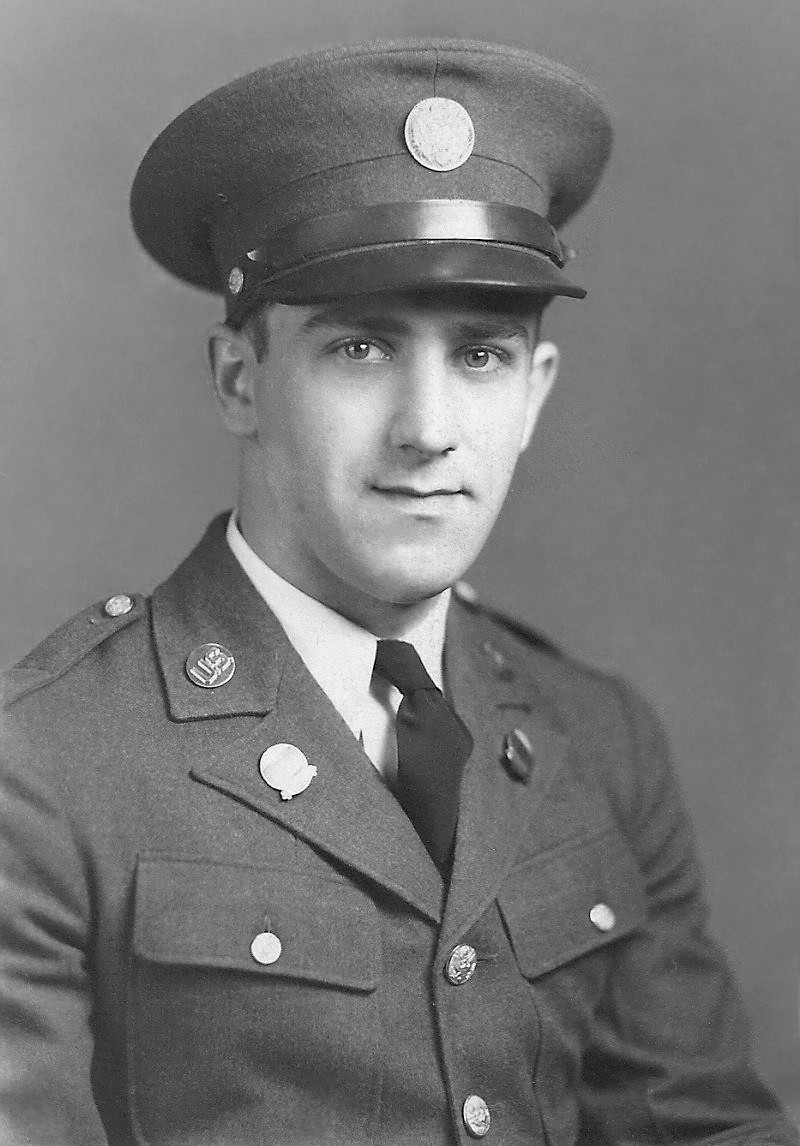Henry Bernard “Bernie” Westhoff, Jr. was born at Newburgh, Orange County, New York on July 25, 1917. He was the third of four children of Henry Bernard Westhoff Sr (9 Nov 1887 – 18 Sep 1960), who was born at Cologne, Germany and immigrated to America about 1911; and Margaret (Bahr) Westhoff (1895 – 17 Jul 1961), who was born at New York City, New York. His parents married at Newburgh, Orange County, New York on September 23, 1914. Henry Westhoff Jr was called 'Sonny' or 'Bernie' by his family and 'Hank' by his friends. He had two older twin sisters, Margaret and Catherine Westhoff, and one younger sister, Ruth J. (Westhoff) Sweeting. By 1920 the family lived at 246 Gertrude Street, Syracuse, Onondaga County, New York, and his father was a bookbinder for the public library. By April 1935 the family lived at 719 Teall Avenue, Syracuse, New York. In August 1944 Henry Westhoff Sr moved his family to the house he bought at 103 Holiday Drive, Mattydale (Syracuse), New York.
Henry Westhoff Jr graduated from Eastwood High School in Syracuse, New York in 1935. He enlisted in the U.S. Army on May 30, 1939. He was 5 feet 8 1/2 inches tall and weighed 129 pounds. He reported for service at Mitchel Field, Long Island, New York on June 1, 1939, and was sent to Cooks & Bakers School at Fort Slocum, Long Island, New York. He was then assigned as a cook at Mitchel Field on November 14, 1939. He was promoted to the rank of Sergeant, Air Corps, at Mitchel Field on January 16, 1941; and to the rank of Staff Sergeant, Air Corps, at Mitchel Field on May 1, 1941. He applied for Army Air Corps pilot training in 1942, and in January 1943 was assigned to the Army Air Forces Classification Center at Randolph Field, San Antonio, Texas. By March 1943 he was selected for pilot training. His Pre-Flight phase of training at San Antonio was delayed by his hospitalization for scarlet fever. On June 28, 1943 he began the Primary phase of pilot training at Corsicana, Texas, but washed out because of difficulty with landings.
He was sent to Army Air Forces gunnery training at Harlingen, Texas, which he completed in November 1943. His next stop was the Army Air Base at Camp Kearns near Salt Lake City, Utah, where he was assigned as an aerial gunner on the heavy bomber crew of Lt Thomas Womer. In December 1943 the Womer crew was sent to Davis-Monthan Field in Tucson, Arizona for initial B-24 crew training. On January 1, 1944 the Womer crew was assigned to the 838th Bomb Squadron, 487th Bomb Group, at Alamogordo Army Air Base, New Mexico. There they completed B-24 crew training and deployed with the Group to England in March 1944. The Womer crew flew B-24H 42-52662 from Alamogordo, New Mexico to Lavenham, England via the southern Atlantic ferry route—a journey of about 10,000 miles—and arrived at Lavenham by mid-April 1944. The 487th Bomb Group was based at Army Air Forces Station 137 near Lavenham, Suffolk, England, and was part of the 8th U.S. Army Air Force in Europe. After arrival in England S/Sgt Westhoff was reassigned as tail gunner on the crew of Lt Norman E. Gross in the 838th Bomb Squadron.
In the early morning hours of June 6, 1944, the 487th Bomb Group dispatched two Squadrons on the first of three missions that the Group flew on D-Day. The Gross crew flew B-24H 42-52629 'Sweatin' It Out' on this mission. The 487th Bomb Group was assigned to bomb a choke point—a road junction—in Caen, France, to disrupt German transportation. The Group's assembly in the dark over England took five hours, much longer than planned. Then a complete undercast prevented the crews from bombing the target. On the return, the entire heavy bomber force was routed away from the Allied shipping area, to the west of the Channel Islands of Jersey and Guernsey. S/Sgt Westhoff and his nine crewmates went missing in action when their aircraft ran out of fuel and went down in the English Channel. A station at Saffron Walden, England received a distress call from the crew at 0842, which indicated that the aircraft was about 35 miles northwest of the Cherbourg Peninsula, and all four engines were dead. The aircraft's last reported position was 49°52'N, 02°38'W, some 20 to 25 miles northwest of the Channel Island of Alderney. Other crews almost ran out of fuel before landing at bases near the English coast.
The remains of Flight Officer Levine, the bombardier, were found by the crew of the British ship HSL 192 (High Speed Launch 192) and were buried at sea, in the English Channel, on July 3, 1944. None of the other crew members was ever found.
S/Sgt Westhoff is memorialized along with his five enlisted crew mates on the Wall of the Missing at Normandy American Cemetery. The four officers on the crew are memorialized on the Wall of the Missing at Cambridge American Cemetery.
He has a cenotaph at Woodlawn Cemetery in Syracuse, New York, where his parents are buried.
B-24H 42-52629 crew:
• Gross, Norman E – 1/Lt – Pilot – MIA
• Haskell, Willard D – 2/Lt – Copilot – MIA
• Moke, Francis E – 2/Lt – Navigator – MIA
• Levine, Milton – F/O – Bombardier – Buried at Sea
• Huebel Jr, Benjamin A – S/Sgt – Engineer – MIA
• Markowitz, Max I – S/Sgt – Radio Operator – MIA
• McWilliams, Charles A – Sgt – Nose Gunner – MIA
• Benson, Stanley J – Sgt – Top Gunner – MIA
• Allensworth, Harold O – Sgt – Ball Gunner – MIA
• Westhoff Jr, Henry B – S/Sgt – Tail Gunner – MIA
Source of information: Paul Webber, www.findagrave.com

